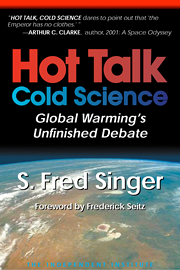The White House has pulled off a magnificent public relations scam on the global warming issue, with great deftness and apparent success. The OSTP (Office of Science and Technology Policy) parlayed a dry technical report by the National Research Council/National Academy of Sciences into an impending climate crisis. Leaking a misleading press release to CBS (which broke the news embargo) weeks prior to President Clinton’s State of the Union address, the Executive Branch laid the groundwork for its message that environmental catastrophe is around the corner “unless we act.” Indeed, President Clinton’s final address to the nation raised fears of “deadly heat waves,” more frequent droughts, flooding of coastal areas, and general economic disruption.
The press release based on the NRC’s report excels in misdirection, a technique quite familiar to magicians and others who want to mislead their audiences. The headline starts with the words “new evidence,” even though there isn’t any. It then claims that the surface temperature of the Earth is rising, deflecting attention away from the main story: The body of the release finally reveals that the atmosphere itself, as measured by weather satellites (and independently by the radiosondes on weather balloons), is not warming. Predictably, the media missed this most important news. The 11-member scientific panel that produced the report “Reconciling Observations of Global Temperature Change” included three of the severest critics of the satellite measurements. Yet, while unable to explain the obvious discrepancy between surface and atmospheric temperature trends, the panel endorsed the validity of the satellite data. The report did note that published climate models that try to simulate the atmosphere on high-speed computers find that the Earth’s atmosphere should warm more rapidly than its surface, but did not point out that this makes the discrepancy between surface and atmosphere trends even worse.
Big puzzle. How to explain the absence of a temperature trend in the atmosphere? Here the press release misleads further. It “helpfully” suggests that perhaps aerosols (tiny reflecting particles created from coal-burning power plants) may cool the atmosphere. But being close to the ground, they should cool the surface even more. Volcanic eruptions, like the 1991 Pinatubo event, likewise also cool the surface.
As an alternative, the press release tries very hard to disparage the satellite data, which reach back only to 1979, by suggesting that 20 years is too short a period to establish the absence of a warming trend. But this ploy is clearly disingenuous as the comparison is with surface data over the same period. And it is generally accepted that earlier surface data, between 1940 and about 1976, show a cooling trend very much at odds with greenhouse climate models.
Why do surface thermometers show a warming trend? It is difficult to accept the hypothesis that the surface warming, as derived from a limited number of observing stations, is real but not also detected in the overlying atmosphere. The report, however, does not delve into the possibility that the surface data may be contaminated, most likely by the local effects of “urban heat islands,” a meteorological term of art describing the increased warming near populated areas where most weather stations are located. Nor does the report discuss which of the several and rather different compilations of surface data are more nearly correct. Part of the problem is that sea surface temperatures are obtained in a number of different ways—island stations, intake water to ship engines, buoys, heat radiation from the ocean surface—that are somehow combined. And the mix has been changing over time, with the latter methods becoming more prevalent in the past few decades.
This hasn’t stopped politically-motivated spin artists from manufacturing fanciful climate catastrophes and trying to impose costly regulatory restrictions and taxes on energy use and other human activities.
The bottom line: While a human influence on climate is theoretically expected, and indeed calculated to be appreciable by current climate models, it may in reality be so small as to be virtually undetectable—and therefore inconsequential. Modelers need to go back to the drawing board. Fears of climate catastrophes are without foundation.









